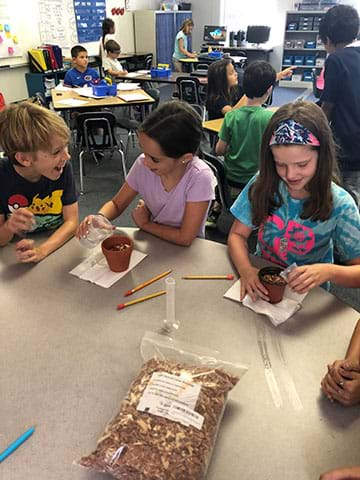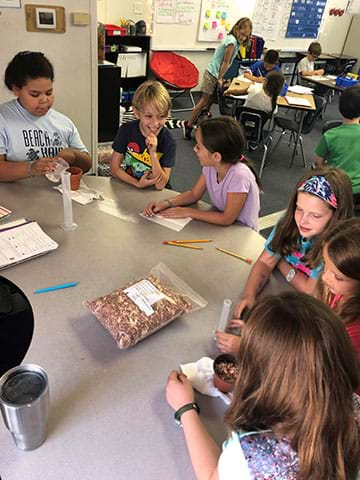Quick Look
Grade Level: Elementary school
Time Required: 3 hours (wild guess!)
(four 45-minute class periods, plus 2 weekends)
Subject Areas: Life Science, Physical Science, Problem Solving

Maker Challenge Recap
In this maker challenge, students utilize the engineering design process as they design a way for mint plants to keep a constant moisture level for 72 hours. The mint plants must be kept moist since they are young and just starting to establish growth. Before students receive the mint plants, they must prove that they can keep the moisture level constant. Students employ the engineering design process and conduct research on different materials used to hold in moisture, evaluate proposed solutions, build and test prototypes, revise and improve their designs, and report their findings to the rest of the class.
Maker Materials & Supplies
- different types of soil or mulch (three to four varieties are ideal)
- different types of pots (8 to 10 cm in diameter) made of plastic and clay (two varieties are ideal)
- assortment of materials to place around and on the soil, such as plastic or aluminum foil
- beaker or graduated cylinder
- water
- cup or trowel (for scooping soil)
- moisture meter, examples available online
- lab notebooks and pens
- poster paper and markers
- mint plants (optional: see Wrap Up below)
Worksheets and Attachments
Visit [www.teachengineering.org/makerchallenges/view/uof-2491-damp-drought-plant-design-challenge] to print or download.Subscribe
Get the inside scoop on all things TeachEngineering such as new site features, curriculum updates, video releases, and more by signing up for our newsletter!Kickoff
Have you ever heard of a drought before? What does that word mean? A drought is a continuous period of time without rain. There are some places around the world that don’t receive rain for months or even years! Do you remember a time where it did not rain for a really long time where you live? What happened to the plants outside? (Discuss these questions with the students.)
What do engineers have to do with plants? For one thing, there are engineers that work in agricultural who discover solutions for plants, animals, and the natural environment. For example, agricultural engineers may develop solutions for plants that need water, but are not receiving enough from the rain, especially in areas with drought-like conditions. Since turning on the sprinklers everyday wastes water, engineers may look for creative ways to help certain plants maintain a constant moisture, especially when young plants are just beginning to establish growth. Think of new plants like yourselves; you are young, but you grow fast with food and water! Some plants need more water than others; without it, they will not survive. If too much evaporation occurs, there will not be enough water for the plant.
You task is to act as agricultural engineers as you conduct research on different soils and bedding to use that maintain a constant moisture for a period of 72 hours! You will use the engineering design process to evaluate proposed solutions that best meet a set of requirements, build and test prototypes, revise and improve your designs, and report on your findings. Since we have to see which design works the best, we will not be using real mint plants… yet!
Resources
- Refer to the Engineering Design Process hub on TeachEngineering to guide your students through the challenge.
- Utilize the Engineering Design Process Notebook for design process documentation.
- Consider visiting the National Drought Mitigation Center website, in particular focus on the section title “Drought for Kids,” which includes information about how people prepare for droughts and how droughts affect the environment.
- Consider showing Drought - The Dr. Binocs Show by Peekaboo Kidz, which presents droughts in a kid-friendly video.
- It may help students to show different images of plants have plenty of moisture versus plants that do not. Discuss what is different about the color and texture of the soil and what the plant looks like.
Maker Time
- Create groups of 2 to 3 students.
- Offering up the library or class computers, have students research what types of soil, mulch, or dirt works best to contain moisture over a long period of time. Explain to students that their goal is to have the moisture meter still read as “moist” after 72 hours. Tell students that they should be writing useful information down in their lab notebooks to use to help build their prototypes. They also need to choose a container (either a clay or plastic pot) and material (if any) they would like to use to cover their soil to hold in moisture.
- Groups should draw the prototype that they would like to design in their lab notebooks, complete with appropriate labels and explanations of materials.
- Give each group about 0.5 L of the soil of their choice to put in their container. Guide students to build and evaluate their prototypes. They should decide how much water to use as well. When groups are ready, give them the moisture meter to stick in the center of their design to see where it reads; it should read moist or wet. Explain to students that their designs will be outside for 72 hours.
- When the 72 hours is up, student groups should use the moisture meter to see if their design kept moist and record the reading in their lab notebooks. With their groups, students should discuss what worked, what did not work, and what they could change to reach their goal.
- Allow students to redesign if necessary. They should draw their next design in their lab notebooks with new explanations of materials. Repeat the above steps.

Wrap Up
Give each group one piece of large chart paper and markers so they can present their design. Students should include the following on their poster:
- The challenge: can we design a prototype that maintains moisture for at least 72 hours?
- A drawing of their final design.
- What they changed in each design phase.
- What they learned from failed tests of certain materials and designs.
As an extension, consider doing the challenge with real mint plants. (Find the mint plants either online or at a local nursery.)
Tips
- While circulating and guiding the students through the design process, make sure they are recording everything that they are doing in their lab notebooks. If needed, have a mini lesson about documenting in lab notebooks beforehand.
Copyright
© 2019 by Regents of the University of Colorado; original © 2019 University of FloridaContributors
Kayla SutcliffeSupporting Program
Multidisciplinary Research Experiences for Teachers of Elementary Grades, Herbert Wertheim College of Engineering, University of FloridaAcknowledgements
This curriculum was based upon work supported by the National Science Foundation under RET grant no. EEC 1711543— Engineering for Biology: Multidisciplinary Research Experiences for Teachers in Elementary Grades (MRET) through the College of Engineering at the University of Florida. Any opinions, findings, and conclusions or recommendations expressed in this material are those of the authors and do not necessarily reflect the views of the National Science Foundation.
Last modified: July 27, 2020





User Comments & Tips